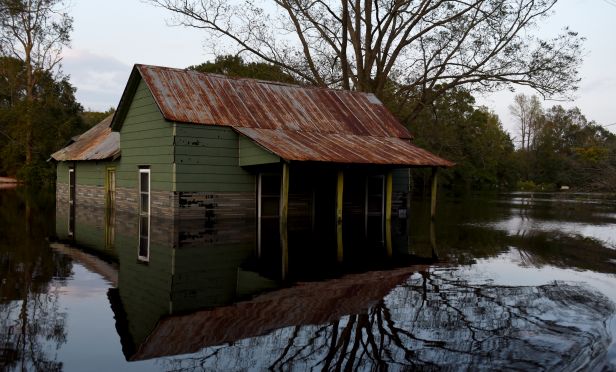 A house stands partially submerged by floodwaters after Hurricane Florence hit in Bergaw, North Carolina, on Thursday, Sept. 20, 2018. (Photo: Callaghan O'Hare/Bloomberg)
A house stands partially submerged by floodwaters after Hurricane Florence hit in Bergaw, North Carolina, on Thursday, Sept. 20, 2018. (Photo: Callaghan O'Hare/Bloomberg)
(Bloomberg) – Hurricane Florence is likely to end up costing insurers far less than initially feared.
Before making landfall, the storm weakened significantly, largely sparing the bigger inland population centers of the Carolinas. While Florence did wreak havoc with record flooding, private insurers typically aren't on the hook for those losses, which tend to be covered by the federal government's National Flood Insurance Program.
Recommended For You
In the days before Florence hit North Carolina on Sept. 14 as a Category 1 storm, catastrophe modeler Risk Management Solutions looked at potential historical benchmarks of $15 billion to $20 billion in covered losses for insurers from wind and coastal storm-surge damage.
This week, AIR Worldwide, a unit of Verisk Analytics Inc., said insured losses would be between $1.7 billion and $4.6 billion. Another firm, Karen Clark & Co., put the figure at $2.5 billion. Those estimates exclude damage from flooding covered under the National Flood Insurance Program. Risk Management Solutions hasn't publicly released an estimate of covered losses since the storm dissipated.
"The losses were low because it was a Category 1, but it was enhanced a little bit because of the duration," said AIR Worldwide director of meteorology Peter Sousounis. "Storm surge was reflective of a much more significant storm, the wind was not."
Prior to Florence's landfall, the storm slowed from Category 4 winds to Category 1 speeds. That spared private insurers from facing higher losses tied to wind damage, which they'd typically be on the hook for.
Real damage coming from flooding
"The real damage is not coming from the wind, which is where you tear off roofs," said Alexandra Glickman, a managing director at insurance brokerage Arthur J. Gallagher & Co. "The real damage is coming from the flooding."
Many insurers have yet to report specific costs related to Florence as they work to assess the damage. Allstate Corp., the largest publicly traded U.S. home and auto insurer, advanced for six straight days through Thursday. The stock was little changed Friday.
Slow moving storm caused more damage
The storm, however, moved slowly, causing more damage as it persisted over land. Record flooding destroyed structures and breached a landfill that held potentially toxic coal ash. The storm is being blamed for at least 42 deaths in three states, Associated Press reported.
Consulting and actuarial firm Milliman Inc. estimated that fewer than 10% of households affected by Florence in North and South Carolina are likely to have federal flood insurance. That doesn't include private flood coverage.
Despite the damage, the insurance industry is well-capitalized.
"Even though it's a relatively small loss in the grand scheme of things, there's always a bit of upset," said Gary Marchitello, head of property brokering at Willis Towers Watson Plc. "It's not a number that's going to shake the market either locally or globally."
Got photos to share? We'd like to see them. PropertyCasualty360.com readers who have images of Florence's path can send them via e-mail to [email protected], for inclusion in our coverage.
© Touchpoint Markets, All Rights Reserved. Request academic re-use from www.copyright.com. All other uses, submit a request to [email protected]. For more inforrmation visit Asset & Logo Licensing.







